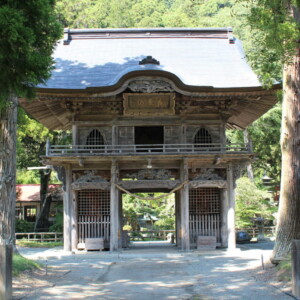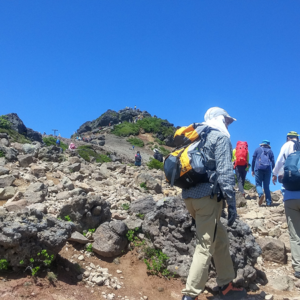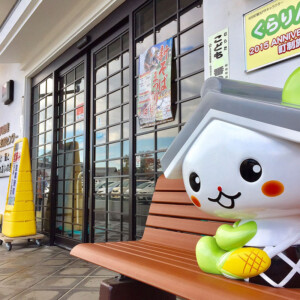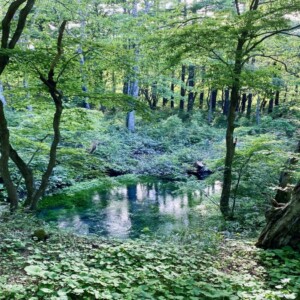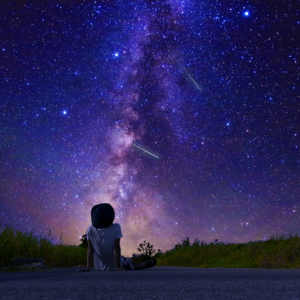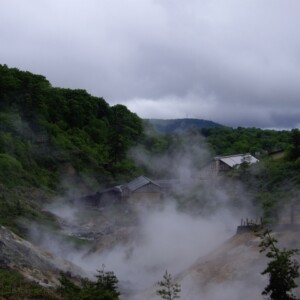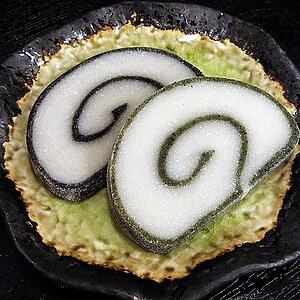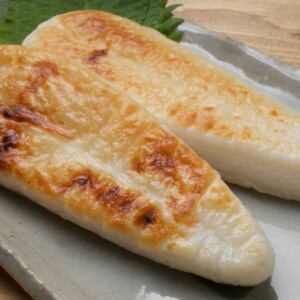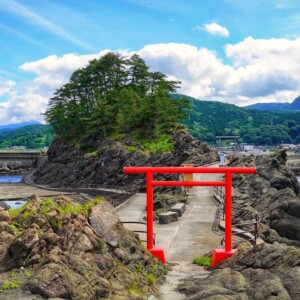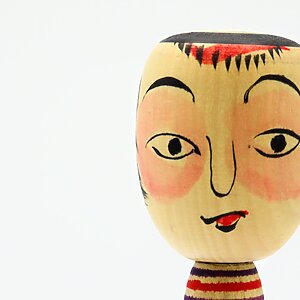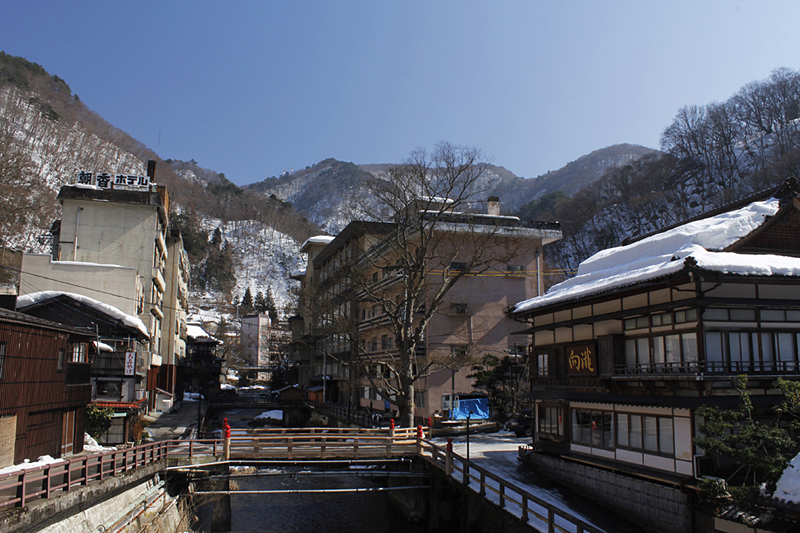
[Aizuwakamatsu City, Fukushima Prefecture] Aizu Higashiyama Onsen Mukaitaki, a cultural property inn, where you can feel at ease with Japanese warmth and warm hospitality.
table of contents
- 1 First designated registered tangible cultural property. Mukaitaki was a sanatorium for the Aizu clan during the Edo period.
- 2 The first registered "entrance building" with a large hall and "fox bath"
- 3 The oldest "guest room building" said to have been built since the Edo period
- 4 A “continuous building” along the mountain built by carpenters from Aizu and Tokyo in collaboration
- 5 “Hanare” was the “palace where the royal family stayed”
- 6 A hot spring that warms your body from the core with continuous flowing water.
- 7 Mukaitaki is full of charm beyond its buildings and hot springs.
- 8 Check details on accommodation reservation site
"Aizu Higashiyama Onsen" is a hot spring resort representative of the Aizu region, located on the outskirts of Aizuwakamatsu City, Fukushima Prefecture. Hot springs have a long history, and are said to have been discovered by the monk Gyoki about 1,300 years ago when he visited Aizu to spread Buddhism. Gyoki devoted himself to building the Great Buddha in Nara, and was the first high priest to receive the highest rank of Daisojo.
During the Edo period, it prospered as a hot spring spa for the Aizu clan, and in the Meiji period, the Aizu folk song ``Aizu Bandaizan'' sang, ``Shosuke Ohara loved morning naps, morning sake, and morning baths, and he ruined his life with them.'' The name ``Aizu Higashiyama Onsen'' became famous nationwide.
The inns are lined up along the Yukawa River that runs through the center of the town. If you look closely at the inn names, you'll see that many of them have the word ``taki'' in them, such as ``Harataki,'' ``Shintaki,'' ``Taki no Yu,'' and ``Mukaitaki.'' However, there are many small waterfalls in Yukawa, and the name of the inn is It is said that the inn was named after a nearby waterfall.
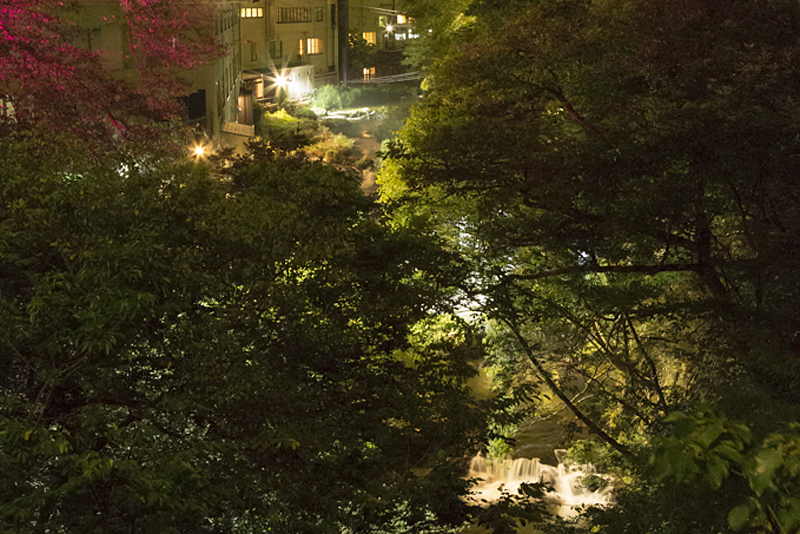
The quality of the spring is sodium, calcium, sulfate, and chloride, and it has a gushing rate of approximately 1,500 liters per minute. Many inns have their own hot springs. It is a colorless and transparent alkaline hot spring that is gentle on the skin.
Aizu Higashiyama Onsen Tourism Association<Information>
- Phone number: 0242-27-7051
- Official URL: Aizu Higashiyama Onsen Tourism Association
First designated registered tangible cultural property. Mukaitaki was a sanatorium for the Aizu clan during the Edo period.
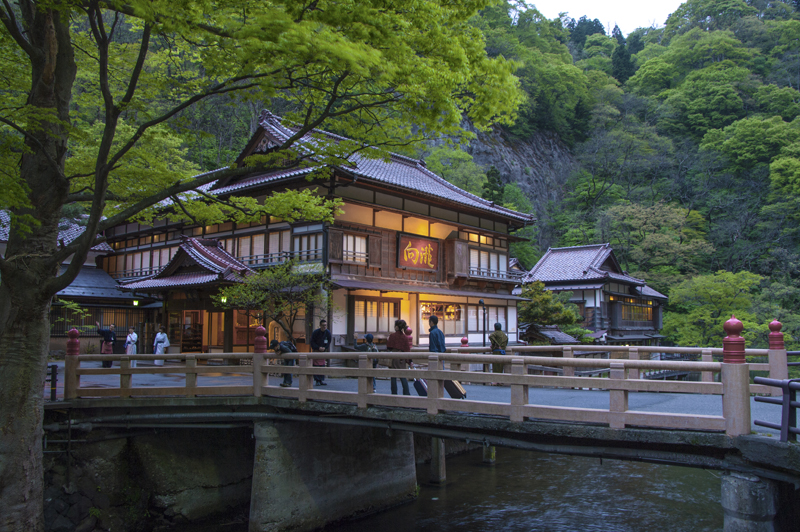
In the middle of the hot spring town, there is an inn with a beautiful old-fashioned wooden structure. This is ``Mukaitaki.'' It has a long history, and was established as a sanatorium designated by the Aizu domain during the Edo period, ``Kitsuneyu.'' In the Meiji era, it was inherited and became the hot spring inn "Mukaitaki".
Almost all of the buildings at Mukaitaki were built between the Meiji and early Showa periods, and are still in use as guest rooms. The splendor of the building is such that it was designated as the first nationally registered tangible cultural property in 1996 as a historical cultural property worthy of long-term preservation.
Photos of the construction at the time are posted on the Mukaitaki website, and you can see that the guest rooms were built on a slope, so it was a lot of work. There was also a carpenter who came from Tokyo. The guest rooms are purely Japanese-style, and each room has a different design, such as the openwork carvings on the transoms, the design of the shoji screens, and the structure of the study room, so no two rooms are the same. You can clearly see the high level of skill of the carpenter.
The first registered "entrance building" with a large hall and "fox bath"
Once you cross the Yukawa River, you will reach the entrance. This is a two-story wooden "entrance building" built in the late Meiji period and renovated in the early Showa period, which was the first to be registered.In addition to the entrance and kitchen, there is a large hall and guest rooms on the second floor, and a bathroom in the basement. there is. This bath is a hot spring bath called "Kitsuneyu" that dates back to the Edo period.
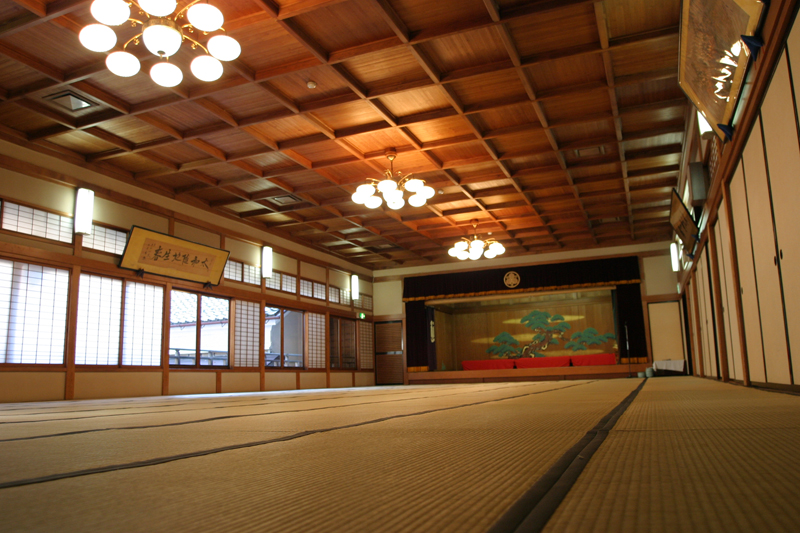
The "Great Hall" has a formal high ceiling and a "hinoki stage" made of all-Japanese cypress.In 1992, the banquet of the "Quadrolar Trade Summit", an international conference attended by the Ministers of International Trade and Industry of the United States, Canada, the EC, and Japan, was held here. It has been.
The oldest "guest room building" said to have been built since the Edo period
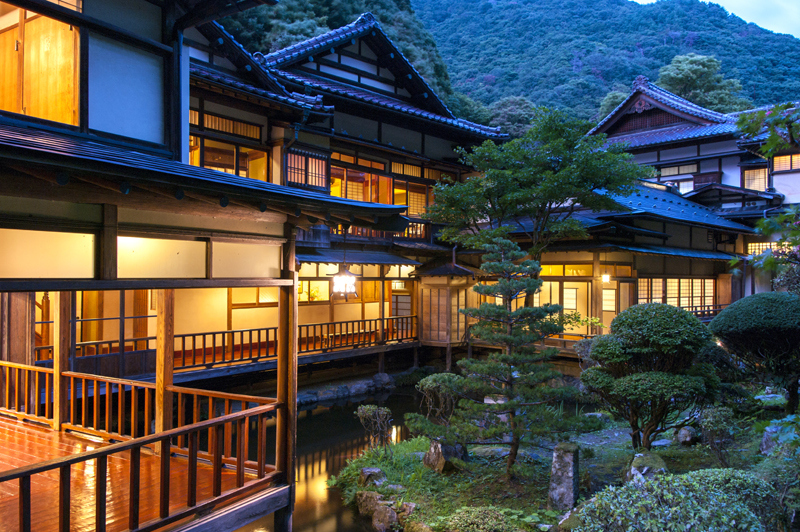
If you continue down the hallway, you will see a garden with a pond on the left, a private family bath on the right, and guest rooms on the second floor. The hallway is a corridor, and you can always see the garden. The area from the hallway to here is Mukaitaki's oldest guest room building (registration No. 3). This ``guest room building'' is said to have existed since the mid-Edo period, although the facilities were later renovated.
A “continuous building” along the mountain built by carpenters from Aizu and Tokyo in collaboration

Along the mountain in the back, there is a ``continuous building'' consisting of conference rooms and guest rooms. The conference room is the only Western-style building in Mukaitaki. There are guest rooms on the upper floor of the conference room, which are built along a slope, making it a bit difficult to go up and down the stairs. It was built by carpenters from Aizu and Tokyo in cooperation, so the sophisticated craftsmanship, careful attention to materials, and room names that can be seen in Hakone and Izu remain throughout. Construction of the ``continuous building'' began in 1933 and was completed in 1933 (Registered No. 4).
“Hanare” was the “palace where the royal family stayed”

If you go down the hallway to the left from the entrance building, there will be stairs, and there will be a ``separate'' at the top. This is also a registered tangible cultural property and was built in the late Meiji period (registration number 2).
``Hanare'' has three rooms, each with its own hot spring bath. In the room, there is a book written by Hideyo Noguchi that says ``Bishukakou'' (Both sake and food are delicious). The structure of the main room is a typical shoin-zukuri style. In the Taisho era, it was described in the guide to the hot spring town as "a designated building by the Imperial Household Agency, where members of the imperial family stayed overnight." Of course, you can stay overnight at Hanare.
A hot spring that warms your body from the core with continuous flowing water.
There are three hot spring baths: ``Kitsune-yu'', ``Saru-no-yu'', and ``Private Family Bath''.
``Kitsuneyu'' has been around since the Edo period, which is a bit hot.

The source of “Kitsuneyu” is said to have been flowing for 1300 years ©Mukaitaki
``Kitsuneyu'' is located in the basement of the entrance building and is a bath that uses natural hot spring water that has been gushing out since ancient times. The hot water is drawn directly from a natural source along the Yukawa River, and the spring temperature is a bit hot at 45℃. The pure white hot spring flowers near the spout are proof that the hot spring has a high concentration of ingredients. There are separate baths for men and women, but there are no showers.
Open indoor bath “Saru no Yu”
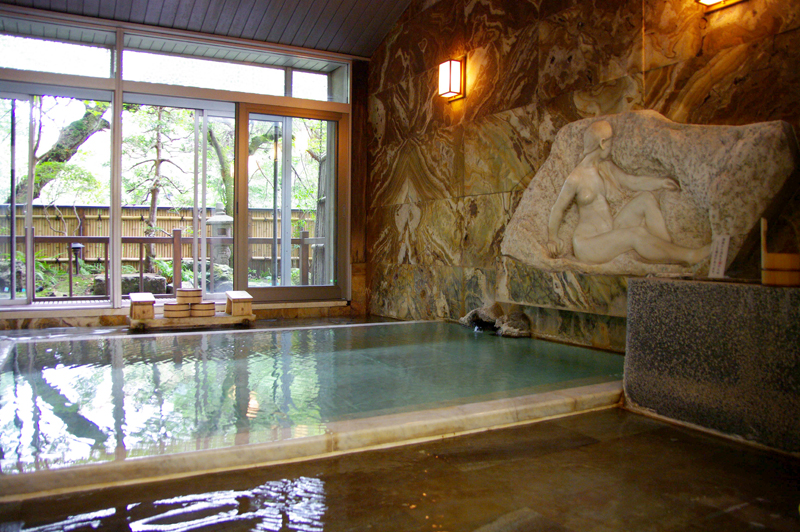
"Saru no Yu" is a large public bath for men and women. There is no open-air bath, but it is an open indoor bath where you can see the lush nature through the large glass windows. ``Saru no Yu'' is a little far from the source, so the water temperature is a little lukewarm at 42℃. Separate for men and women, with showers and hot spring baths.
"Private family bath" that can be used free of charge at any time
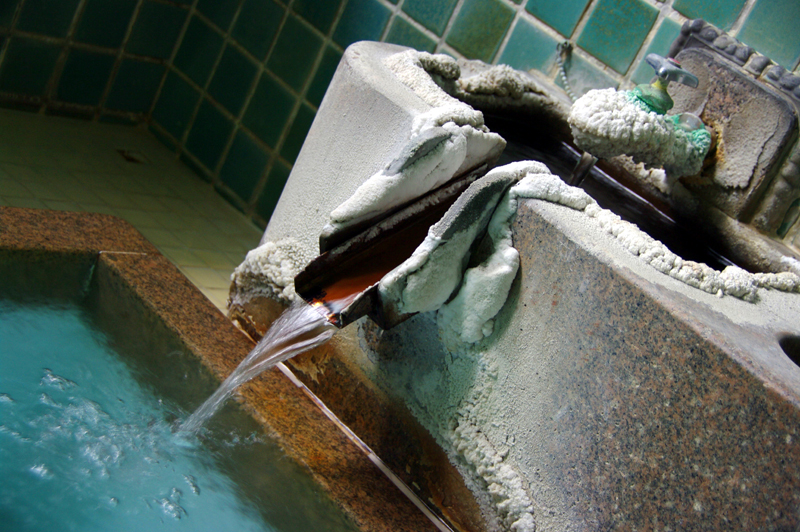
There are three ``private family baths.'' They have names such as “Tsuta no Yu,” “Hyo no Yu,” and “Suzu no Yu,” and each has a different carving on the ceiling. It's also nice that you can use it for free whenever there is space.
All hot spring baths are fed directly from the source. Also, since no water is added or heated, you can enjoy hot springs as they are from the source. Unfortunately, day use is not possible.
Mukaitaki is full of charm beyond its buildings and hot springs.
Mukaitaki still has many charms, such as its cuisine, gardens, and hot springs. Let me introduce it a little.
Local cuisine centered on Aizu ingredients
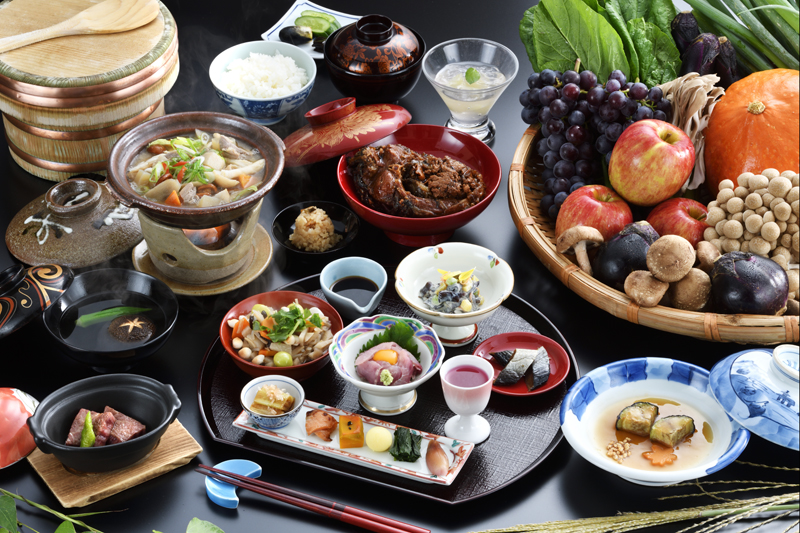
Meals for both dinner and breakfast are delivered to your room. Local cuisine made with seasonal ingredients grown in Aizu. You can enjoy the flavors unique to the Aizu region, such as kozuyu and sweet stew of carp.
A stroll-style Japanese garden that makes good use of the slope

``Mukaitaki'' is built on a slope, so it is quite difficult to climb the stairs to access some of the rooms. However, the well-maintained garden can be seen from the corridor leading to the room, which soothes the soul. There is a pond just below the corridor, and trees and stones are placed on the slope, making it a stroll-style Japanese garden that is beautiful no matter where you look at it in each season.
Check details on accommodation reservation site
Aizu Higashiyama Onsen Mukaitaki<Information>
- Name: Aizu Higashiyama Onsen Mukaitaki
- Address: 200 Yumotokawamukai, Higashiyama-cho, Aizuwakamatsu-shi, Fukushima 965-0814
- Phone number: 0242-27-7501
- Official URL: https://www.mukaitaki.com/



![[Fukushima Prefecture] Full of unique accommodations! Hot spring inns you want to stay at when you go to Aizu Tsuruga Castle (Aizuwakamatsu)](https://jp.neft.asia/wp-content/uploads/2018/03/428179_m-150x150.jpg)

![[Fukushima] Along with sightseeing at Tsuruga Castle. “Aizu Ramen Show” is finally starting! 1e2675187f4dad35bc59e28f4a767e23_m](https://jp.neft.asia/wp-content/uploads/2017/10/1e2675187f4dad35bc59e28f4a767e23_m-150x150.png)
![[Aizuwakamatsu City, Fukushima Prefecture] “Aizu Thirty-Three Kannon” tours around the Kitaaizu area, centering on Aizuwakamatsu 25949683_m](https://jp.neft.asia/wp-content/uploads/2023/02/25949683_m-150x150.jpg)
![[Aizuwakamatsu City, Fukushima Prefecture] The biggest festival in Aizu! Aizu Festival 2023 holding information 634-1569](https://jp.neft.asia/wp-content/uploads/2023/08/634-1569-1-150x150.jpg)

![Kakunodate, which was built by the Ashina clan in the Edo period, began with the Tozawa clan during the Sengoku period [2] Cherry blossoms on the Hinokiuchi River Dynasty Night Cherry blossoms_Akita Fan](https://jp.neft.asia/wp-content/uploads/2025/07/98886c5b97b9b3f8d61f0ae473e583b1-150x150.jpg)

